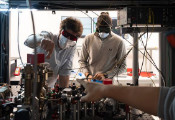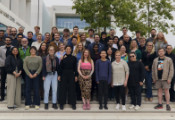Coupling Microwave Photons to Germanium Quantum Dots
December 04, 2024 -- Quantum computing is poised to change the way we approach science and technology, solving problems that are currently intractable. However, to unlock this potential, scientists face the challenge of creating reliable and scalable 'qubits'— the quantum equivalent to our computer bits—that can process quantum information.
Germanium, a material with exceptional properties, offers a promising platform for creating "hole-based" qubits, which rely on the absence of electrons, or "holes," to store and process quantum information. Germanium’s strong “spin-orbit interaction” allows for fast and precise electrical control of spin qubits, a key advantage for scalable quantum computing architectures.
A team lead by EPFL professor Pasquale Scarlino, in collaboration with researchers from the Institute of Science and Technology Austria, Polytechnic University of Milan, and the University of Basel, successfully coupled hole qubits in germanium quantum dots to a high-impedance “SQUID array resonator”—a superconducting device capable of trapping microwave “photons”, particles of light. This resonator greatly boosted the interaction between the photons and the charge of the trapped holes, leading to a phenomenon known as “vacuum-Rabi splitting,” which occurs when photons and qubits exchange energy so strongly that they can no longer be treated as separate systems. As a result, their energy levels split into two distinct states when in resonance, marking a hallmark achievement of strong coupling.
Strong photon-qubit coupling is crucial for scalable quantum technologies, as it allows for enhancing the qubit state detection and the potential transfer of quantum information across distances. The EPFL team’s achievement therefore represents a major step toward integrating Germanium quantum dots into future quantum computing architectures.
The exceptional sensitivity of their setup, facilitated by the strong coupling, enabled the researchers to uncover and investigate Wigner molecules—unique quantum states arising from the interplay of the QD confinement and the strong Coulomb interactions between holes (which are positively charged). The team leveraged these states, which have unique properties that make them useful for interacting with a particle's spin. Notably, these Wigner molecular states, which involve spin transitions, can last longer while still being strongly connected to the resonator. This connection is important for linking multiple systems together, showing their potential for advanced quantum technologies.
“This work demonstrates the enormous potential of germanium quantum dots for building scalable and robust quantum systems,” says Scarlino. “Strong coupling to photons and the ability to probe complex quantum states open exciting avenues for future research and technology.”
By integrating strong hole charge-photon coupling with the advanced study of Wigner molecules, this work positions germanium as a potential leading material for next-generation spin qubit-based quantum computing, combining scalability, stability, and versatility in one platform.




































